FLIGHT I
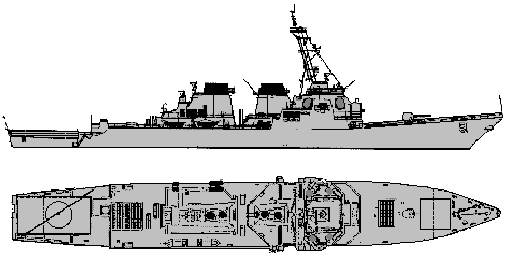
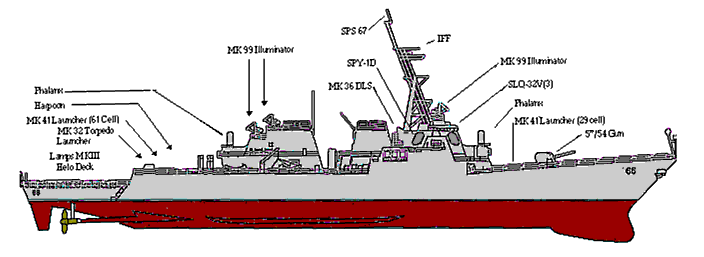
FLIGHT IIA
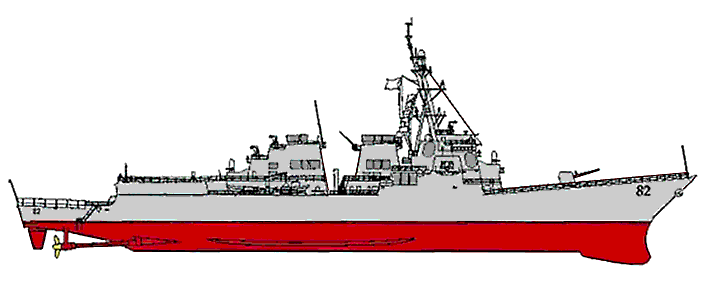
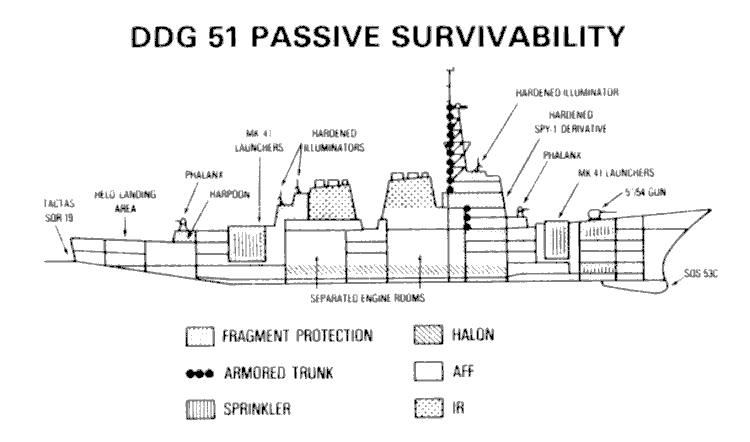

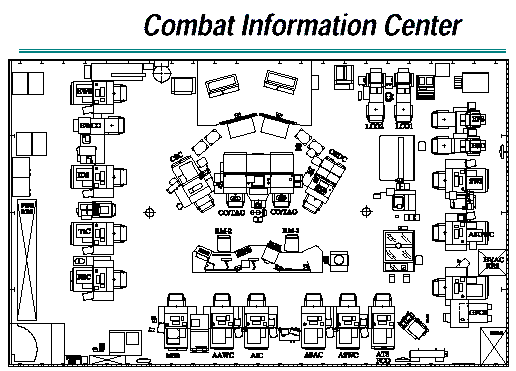
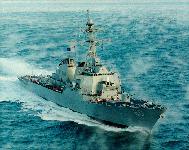
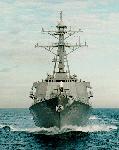
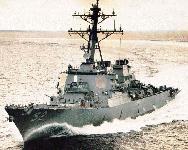




DDG 51s were constructed in flights, allowing technological advances during construction. Flight II, introduced in FY 1992, incorporates improvements to the SPY radar and the Standard missile, active electronic countermeasures and communications. Flight IIA, introduced in fiscal year 1994, added a helicopter hangar with one anti-submarine helicopter and one armed attack helicopter.
The initial ARLEIGH BURKE-class guided missile destroyers have a full load displacement of 8,300 tons, are 506 feet in overall length and have a 62 foot beam. They are driven by two shafts powered by four LM2500 engines. Their maximum speed is in excess of 30 knots and they have a cruising range of 4,400 n. miles at 20 knots. The ships complement is about 30 officers and 302 enlisted personnel.
All ships of this class have the AEGIS air defense system with the SPY-1D phased array radar. They are armed with a 90-cell Vertical Launching System capable of storing and rapidly firing a mix of Standard, Tomahawk, and Vertically Launched ASROC (VLA) missiles for either Air Defense, Strike Warfare, or Anti-Submarine Warfare missions. Other armament includes the Harpoon anti-ship cruise missile, the 5"/54 gun with improvements that integrate it with the AEGIS weapon system, and the Phalanx Close-in Weapon System for self-defense.The AN/SPY-1D Phased Array Radar incorporates significant advances in the detection capabilities of the AEGIS Weapons System, particularly in its resistance to enemy Electronic Counter-Measures (ECM). The AEGIS system is designed to counter all current and projected missile threats to the Navy's battle forces. A conventional, mechanically rotating radar "sees" a target when the radar beam strikes that target once during each 360 degree rotation of the antenna. A separate tracking radar is then required to engage each target. In contrast, the computer-controlled AN/SPY-1D phased array radar of the AEGIS system brings these functions together within one system. The four fixed arrays of "SPY" send out beams of electromagnetic energy in all directions simultaneously, continuously providing a search and tracking capability for hundreds of targets at the same time. Using the SPY-1D and her Mark 99 Fire Control System, these ships can guide vertically-launched Standard Missiles to intercept hostile aircraft and missiles at extended ranges. To provide point defense against hostile air targets, the ships are equipped with the Block 1 upgrade to the Phalanx Close-In-Weapons System (CIWS).
The ARLEIGH BURKE Class is also equipped with the Navy's latest ASUW Combat Systems. Land attack cruise missile capability is provided by Tomahawk Missiles, which are launched from her Mark 41 Vertical Launching System (VLS). The MK 41 VLS is a multi-warfare missile launching system capable of firing a mix of missiles against airborne and surface threats. It is modular in design, with eight modules symmetrically grouped to form a launcher magazine. The modules contain all the necessary components for launching functions when interfaced with the ship's AEGIS Weapon System. VLS is a product of Martin-Marietta. The shorter range Harpoon Anti-Ship Cruise Missiles have a range in excess of 65 nautical miles which are fired from stand-alone launchers. The 5"/54 Caliber Gun, in conjunction with the Mark 34 Gun Weapon System, is an anti-ship weapon which can also be used for close-in air contacts or to support forces ashore with Naval Gun-Fire Support (NGFS).
The AN/SQQ-89 integrated ASW Suite is the most advanced anti-submarine warfare system in the world today. The AN/SQR-19 Tactical Towed Array SONAR (TACTAS) provides extremely long-range passive detection of enemy submarines, and the AN/SQS-53C Hull-Mounted SONAR is used to actively and passively detect and locate submarine contacts. The ships also have the capability to land the SH-60B LAMPS Mark III Helicopter, which can link to the ship for support in the anti- submarine operations, as well as conducting over-the-horizon targeting missions. These systems are supplemented by the SLQ-32V(2) Electronic Warfare Suite, which includes passive detection systems and decoy countermeasures.
A new, large, waterplane area hull form significantly improves seakeeping ability. The hull form is designed to permit high speed in high sea states. The seakeeping hull form is characterized by considerable flair and a "V" shape appearance at the waterline.The DDG-51 Class engineering plant represents an improvement in US Naval gas turbine power plant control systems. Aircraft derivative gas turbines are used for both propulsion and ship service electrical power generation. A high degree of plant automation is achieved by an interconnected system of control consoles. Four of these control consoles are located in the Central Control Station (CCS) which is the nerve center of the DDG-51 Class engineering plant.
Four General Electric LM2500 Gas Turbine Engines (GTEs) provide ship's propulsion. Each Engine Room contains two LM2500s, one propulsion reduction gear to convert the high speed, low torque output of the gas turbine engine to low speed, high torque output suitable to drive the propulsion shafting, and the related support systems and equipment. The port shaft connects 2A and 2B GTEs in Main Engine Room #2 and the starboard shaft connects 1A and 1B GTEs in Main Engine Room #1. When viewed from the stern, the port shaft rotates counterclockwise and the starboard shaft clockwise, producing outward propeller rotation. Since the GTEs cannot be reversed, the Controllable Pitch Propeller (CPP) system provides ahead and astern thrust by hydraulically positioning the pitch of the propeller blades.
Each of the three Gas Turbine Generator Sets (GTGS) is rated at 2500 KW and supplies 450 VAC, three-phase, 60 HZ power. #1 GTGS is located in Auxiliary Machinery Room #1, #2 GTGS is located in Main Engine Room #2, and #3 GTGS is located in #3 Generator Room. The GTGS are separated from each other by three watertight bulkheads for survivability. Each Gas Turbine Generator Set is comprised of an Allison 501-K34 Gas Turbine Engine, a module assembly, a reduction gear assembly, and a generator.
The DDG-51 Class ships are specifically constructed from a survivability-enhanced design that affords passive protection to personnel and vital systems. This design provides protection against underwater shock, nuclear air blasts, fragment incursions into vital spaces, radar detection, electronic countermeasures, gun and missile attacks and a Chemical, Biological and Radiological (CBR) attack. A comprehensive Collective Protection System guards against nuclear, chemical, or biological agents. The ship's damage control features and constructional design make the DDG-51 Class Destroyer the most "survivable" surface ship in the world.
In the ARLEIGH BURKE Class, all-steel construction is used. Extensive top-side armor is placed around vital combat systems and machinery spaces. The bulkheads are constructed of steel from the waterline to the pilot house. The bulkheads are designed with double-spaced plate construction for fragment protection. The frontal plate causes fragments to break up and the backup plate stops the fragments from causing further damage to the interior of the ship. Othe Aegis combat system equipment rooms are protected by Kevlar shielding. And, topside weight is reduced by incorporating an aluminum mast.
Acoustic, infrared, and radar signatures have been reduced, and vital shipboard systems are hardened against electro-magnetic pulse and over-pressure damage. Sound isolators or "shock absorbers" have been placed on the reduction gears, giving the ship an added advantage when pursuing submarines. State-of-the-art propulsion and damage control systems are managed by an all-new data multi-plexing system. Fire detectors and increased AFFF and Halon protection add to improved survivability.
Ingalls Shipbuilding builds Aegis destroyers using modular techniques pioneered by the shipyard in the 1970's, and refined during two decades of assembly line construction of destroyers, cruisers, and amphibious assault ships. The ships also benefit from Ingalls' pioneered efforts to integrate advanced computer technology into ship design and construction. The design process for ships built at Ingalls is accomplished using a three-dimensional Computer-Aided Design (CAD) system, which is linked with an integrated Computer-Aided Manufacturing (CAM) production network of host-based computers and localized minicomputers throughout the shipyard. Ingalls' system produces digital data used by the CAM equipment to electronically direct the operation of numerically-controlled manufacturing equipment cutting steel plates, bending pipe, and laying out sheetmetal assemblies, and supporting other manufacturing processes. The technology significantly enhances design efficiency, and reduces the number of manual steps involved in converting design drawings to ship components, improving productivity and efficiency.
During the construction of a DDG-51 destroyer, hundreds of subassemblies are built and outfitted with piping sections, ventilation ducting and other shipboard hardware. These subassemblies are joined to form dozens of assemblies, which were then joined to form the ship's hull. During the assembly integration process, the ship is outfitted with larger equipment items, such as electrical panels, propulsion equipment, and generators. The ship's superstructure, or "deckhouse," is lifted atop the ship's midsection early in the assembly process, facilitating the early activation of electrical and electronic equipment. When the ship's hull integration was complete, the ship is moved over land via Ingalls' wheel-on-rail transfer system, and onto the shipyard's launch and recovery drydock.
The Navy had 38 Arleigh Burke-class destroyers in its force, under construction, or under contract as of April 21, 1997, and planned to procure an additional 19 destroyers through the next decade, completing the 57 ship DDG-51 program by procuring the remaining ships through fiscal year 2004. The Navy plans to build 12 ships between 1997 and 2001 which are planned to be delivered to the fleet without cooperative engagement or theater ballistic missile defense capability.
DDG 51 class ships were originally planned to be procured at a rate of five per year. A forty-five percent reduction in the procurement rate since the program began has resulted in higher unit costs, lower efficiency, poor overhead planning, and questionable viability of shipbuilders and key subcontractors. To mitigate the risks associated with industrial base stability, the Navy proposes building at a more constant rate of three DDG 51s per year. Completion of the Arleigh Burke destroyer program, along with the earlier procurement of Ticonderoga-class cruisers, will allow the Navy to achieve a force of 84 Aegis-capable surface combatants by fiscal year 2010.
Congress appropriated $3.6 billion for construction of 4 new destroyers in fiscal year 1997 and gave the Navy authority to procure a total of 12 destroyers in fiscal years 1998 through 2001 using a multiyear acquisition strategy. In its biennial budget submission for fiscal years 1998 and 1999, the Navy requested about $2.8 billion and $2.7 billion, respectively, for a total procurement of six destroyers. The FY 1999-2003 shipbuilding program included funds for 15 DDG-51-class destroyers, achieving the procurement objective of 57 of these ships. Twelve of the 15 DDG-51s will be procured under a multiyear acquisition strategy approved by Congress in the FY 1998 budget. The changes made to the shipbuilding program this year have achieved a stable procurement rate of three DDG-51s per year in FY 1999-2003. Advance procurement funds are programmed for FY 2001 to support the revised acquisition profile and a possible extension of the multiyear plan that was approved in FY 1998. The FY2001 Future Years Defense Program (FYDP) showed that the Navy plans to buy only two DDG 51 destroyers per year over a three year period (fiscal years 2002 2004) and two destroyers (one DDG 51 and one DD 21) in fiscal year 2005. The Navy's Arleigh Burke (DDG 51) Class Industrial Base Study of 1993 stated that procurement of three destroyers per year could only sustain the destroyer industrial base if some additional, non-DDG 51 work, were available to each sipbuilder. The study also stated that at a rate of two ships per year, a very substantial amount of non-DDG 51 work would be required for each shipbuilder and risk to survival of one or both shipyards could be high. The Navy testified that a proposal to build two DDG 51 ships per year would result in potential reductions in shipyard workforces and the workforce skill mix, and that maintaining the industrial base would be perilous. The Senate Armed Services committee concurred with the Navy's assessment regarding the industrial base at the time of the original study Stretching out this procurement would cause reductions in workforce skill mix that will result in higher costs for not only the DDG 51 ships, but also for other Navy work in the shipyards that build DDG 51 ships. In fact, the FY2001 budget request showed a dramatic cost increase of between $60.0 million and $100.0 million per ship when a projected procurement rate of two DDG 51 ships per year was computed. Therefore, buying six ships at a rate of two ships per year for three years would cost the taxpayers between $360.0 and $600.0 million more than buying the same ships over a two year period. The Navy appeared to be willing to pay this premium in an attempt to partially accommodate the destroyer industrial base potential problems (three destroyers per year are required to maintain the industrial base) caused by delaying DD 21 one year. The Navy has documented over $1.4 billion in savings by buying three ships per year under the multiyear procurement authority provided by Congress. Continuing the proven economical rate of three ships per year and use of multiyear authority would save additional taxpayer dollars on this program which the Navy intends to complete. Therefore, the Senate Armed Services committee recommended an increase of $143.2 million in advance procurement for DDG 51 to achieve the maximum savings for the taxpayer and to relieve some pressure on the shipbuilding account in future years. The additional advance procurement, coupled with the savings to the taxpayer of buying six ships in two years instead of three years, should result in procurement of six ships on a two year multiyear contract for the approximate cost of five ships procured at a lower rate.Class changes in production Flight IIA critical to littoral warfighting effectiveness include the incorporation of embarked helicopters (SH-60R), an organic minehunting capability and the introduction of area theater ballistic missile defense capability to protect near coastal air-fields and seaports essential to the flow of forces into theater in time of conflict.
The first 28 Arleigh Burke-class destroyers have a helicopter deck but no hanger or embarked helicopters. Ships in production Flight IIA, starting with USS OSCAR AUSTIN (DDG-79), also have landing and hangar facilities for operation of two multi-purpose Light Airborne Multipurpose System LAMPS MK III helicopters. This capability will be added for the remaining 29 ships of the class. The modifications require removal of Harpoon missile capability. The addition of a helicopter hangar and the upgraded baseline 6.1 AEGIS Combat System are two of the most significant upgrades. Also beginning with this ship, the number of VLS cells will be increased from 90 to 96, and the Phalanx close-in weapon system will be replaced by vertical-launched the North Atlantic Treaty Organization (NATO) Evolved Sea Sparrow missiles when they become available.
The construction of the helicopter hangar is the most visible change for this new generation of AEGIS Destroyers. Located aft of the after Vertical Launching System (VLS), the hangar will be large enough to accommodate 2 SH-60F helicopters, support equipment, repair shops and store rooms. Modifications were also made for additional crew required for a helicopter detachment to deploy with the ship. As a result of the increased elevation of the after section of the ship, the aft facing AN/SPY-1D arrays were raised 8 feet to provide visibility over the hangar.
The ship's Recovery, Assist, Securing, and Traversing (RAST) system is utilized to move the helicopter into and out of the port and starboard hangars. Helicopter facilities including the following: dual hangars with bridge cranes and Navy standard helo hangar doors, Helo Control Station, RAST Control Station, Torpedo, Missile and Rocket Magazine with bridge crane and weapons hoist, Landing and Helo In-Flight Refueling (HIFR) facilities for LAMPS MK III SH-60B helicopters. VLA lighting, Stabilized Glide Slope Indicator (SGSI)/ Wave-Off Light System (WOLS) and Horizon-reference set are included. The deck aft is designed for Level I, Class 1, 2A, 4 (Type 2), and 6 Certification, and for RAST operations. Facilities on the bow are designed for Level III, Class A (Type 1) certification.
Starting with Winston Churchill (DDG 81), DDGs will have the 5"/62 cal. gun and dual SH-60R helicopter facilities. They also will have LASM, NFCS and Link 16. The forward fit of the 5 inch 62 caliber gun aboard DDG81, USS WINSTON S. CHURCHILL (DDG81), which commissions in 2001, marks the beginning of the evolution of the highly successful ARLEIGH BURKE class destroyer design to meet the rapidly expanding littoral warfighting mission. McCampbell (DDG 85) marks the introduction of Navy Area TBMD capability aboard DDGs.
The Navy will begin deployment of the remote minehunting vehicle system on a select number of Arleigh Burke class Flight IIA destroyers beginning in 2005. One of the greatest threats to today’s naval battlegroup is mines. In fact, of the 18 U.S. Navy ships destroyed or damaged in conflicts since 1950, mines caused no fewer than 14 of those casualties. To give the modern battlegroup the optimum chance of survival in hostile "brown water" regions, the Program Executive Office for Mine & Undersea Warfare (PEO MUW) began the development of an organic mine-hunting capability to be carried aboard the Navy’s Aegis destroyers. These ships are traditionally among the first surface combatants to enter the littorals ahead of a battlegroup. Once launched from the host ship, the vehicle deploys a towed variable depth sensor (VDS) designed to detect, localize, classify and identify moored and bottom mines in deep and shallow water. The 23-foot long vehicle searches for the mines under the surface of the water. A streamlined combination snorkel and antenna mast, which draws air to the vehicle’s 370 hp Cummins diesel engine, will be its only visible feature above the surface. The remote minehunting vehicle can search for mines autonomously along a pre-programmed track, or can be controlled manually in real-time from the host ship by a single operator. All control and display functions will be integrated with the ship’s AN/SQQ-89 undersea warfare combat system, with mine contact data linked to the Aegis combat system.The Navy intends to incorporate the ideas and technologies from Smart Ship into all 27 of its Ticonderoga class cruisers and 25 Arleigh Burke-class destroyers, starting with DDG 83. These ideas bring automation to maintenance, engineering, damage control, and bridge functions, saving the Navy money.
In early 1996 Bath Iron Works, the lead design yard for DDG-51 Flight IIa, awarded a contract to York International to manufacture 200-ton HFC-134a centrifugal compressor air-conditioning (AC) plants for DDG-83 and follow-on ships. This will be the first installation of the Navy's newly developed ozone-friendly AC plant. Each ship will receive four plants. This plant, in addition to using an ozone-friendly refrigerant, offers significant improvements over the CFC-114 AC plants currently used on DDG-51-class ships.
Navy destroyers have historically been retired by 30 years of service. In recent force planning for ships, the Navy uses notional estimated service lives of 35 years for Aegis-capable cruisers and all current classes of destroyers.
Specifications | |||||
| Power Plant |
4 - LM2500 GE Marine Gas Turbines (100,000 shp) 3 Allison 2500 KW Gas Turbine Generators 2 Shafts with CRP (Controllable Reversible Pitch) Propellers 2 Rudders | ||||
| Length |
| ||||
| Beam | Max 66 Feet waterline 59 feet (18 meters) | ||||
| Navigational Draft | 31 feet | ||||
| Displacement |
| ||||
| Speed | 31 knots (36 mph, 57 kph) | ||||
| Aircraft |
| ||||
| Armament |
Two MK 32 MOD 14 Triple Torpedo Tubes (six MK 50/46 Torpedoes) | ||||
| SENSORS | |||||
| ESM/ECM |
AN/SLQ-32(V)3 AN/SLQ-25A NIXIE Torpedo Countermeasures MK 36 MOD 6 Decoy Launching System (6 Launchers) | ||||
| FIRE CONTROL |
MK116 MOD 7 Underwater Fire Control System AN/SWG- I A (V) Harpoon Launcher Control System AN/SWG-3A TOMAHAWK Weapon Control System | ||||
| EXTERIOR COMMUNICATIONS |
| ||||
| Navigational Equipment |
| ||||
| Replenishment-at-Sea |
| ||||
| Boat Handling and Stowage |
| ||||
| Stability |
Design for ship stability includes the following consideration:
Intact Stability | ||||
| Crew |
| ||||
| Departments |
Administration Combat Systems Engineering Navigation Operations Supply Weapons | ||||
| Unit Operating Cost Annual Average | $20,000,000 [source: [FY1996 VAMOSC] | ||||
Ships | ||||||
| Name | Number | Builder | Homeport | Ordered | Commissioned | Decommissioned |
| FLIGHT I | ||||||
| Arleigh Burke | DDG 51 | Bath | Norfolk | 1985 | 04 Jul 1991 | 2026 |
| Barry | DDG 52 | Ingalls | Norfolk | 1987 | 12 Dec 1992 | 2027 |
| John Paul Jones | DDG 53 | Bath | San Diego | 1987 | 18 Dec 1993 | 2028 |
| Curtis Wilbur | DDG 54 | Bath | Yokosuka | 1989 | 19 Mar 1994 | 2029 |
| Stout | DDG 55 | Ingalls | Norfolk | 1989 | 13 Aug 1994 | 2029 |
| John S. McCain | DDG 56 | Bath | Yokosuka | 1989 | 02 Jul 1994 | 2029 |
| Mitscher | DDG 57 | Ingalls | Norfolk | 1989 | 10 Dec 1994 | 2029 |
| Laboon | DDG 58 | Bath | Norfolk | 1989 | 18 Mar 1995 | 2029 |
| Russell | DDG 59 | Ingalls | Pearl Harbor | 1990 | 20 May 1995 | 2030 |
| Paul Hamilton | DDG 60 | Bath | Pearl Harbor | 1990 | 27 May 1995 | 2030 |
| Ramage | DDG 61 | Ingalls | Norfolk | 1990 | 22 Jul 1995 | 2030 |
| Fitzgerald | DDG 62 | Bath | San Diego | 1990 | 14 Oct 1995 | 2030 |
| Stethem | DDG 63 | Ingalls | San Diego | 1990 | 21 Oct 1995 | 2030 |
| Carney | DDG 64 | Bath | Mayport | 1991 | 13 Apr 1996 | 2031 |
| Benfold | DDG 65 | Ingalls | San Diego | 1991 | 30 Mar 1996 | 2031 |
| Gonzalez | DDG 66 | Bath | Norfolk | 1991 | 12 Oct 1996 | 2031 |
| Cole | DDG 67 | Ingalls | Norfolk | 1991 | 08 Jun 1996 | 2031 |
| The Sullivans | DDG 68 | Bath | Mayport | 1992 | 19 Apr 1997 | 2032 |
| Milius | DDG 69 | Ingalls | San Diego | 1992 | 23 Nov 1996 | 2032 |
| Hopper | DDG 70 | Bath | Pearl Harbor | 1992 | 06 Sep 1997 | 2032 |
| Ross | DDG 71 | Ingalls | Norfolk | 1992 | 28 Jun 1997 | 2032 |
| FLIGHT II | ||||||
| Mahan | DDG 72 | Bath | Norfolk | 1992 | 14 Feb 1998 | 2033 |
| Decatur | DDG 73 | Bath | San Diego | 1993 | 29 Aug 1998 | 2033 |
| McFaul | DDG 74 | Ingalls | Norfolk | 1993 | 25 Apr 1998 | 2033 |
| Donald Cook | DDG 75 | Bath | Norfolk | 1993 | 04 Dec 1998 | 2033 |
| Higgins | DDG 76 | Bath | San Diego | 1993 | 24 Apr 1999 | 2034 |
| O'Kane | DDG 77 | Bath | Pearl Harbor | 1994 | 23 Oct 1999 | 2034 |
| Porter | DDG 78 | Ingalls | Norfolk | 1994 | 10 Mar 1999 | 2034 |
| FLIGHT IIA | ||||||
| Oscar Austin | DDG 79 | Bath | Norfolk | 1994 | 19 Aug 2000 | 2034 |
| Roosevelt | DDG 80 | Ingalls | Mayport | 1995 | 14 Oct 2000 | 2035 |
| Winston Churchill | DDG 81 | Bath | Norfolk | 1995 | 2000 | 2035 |
| Lassen | DDG 82 | Ingalls | building | 1996 | Apr 2001 | 2036 |
| Howard | DDG 83 | Bath | San Diego | 1996 | 2001 | 2036 |
| Bulkeley | DDG 84 | Ingalls | Norfolk | 1996 | 2001 | 2036 |
| McCampbell | DDG 85 | Ingalls | building | 1996 | 2001 | 2036 |
| Shoup | DDG-86 | Ingalls | authorized | 1997 | 2002 | 2037 |
| Mason | DDG-87 | Bath | authorized | 1997 | 2002 | 2037 |
| Preble | DDG-88 | Ingalls | authorized | 1997 | 2002 | 2037 |
| Mustin | DDG-89 | Ingalls | authorized | 1998 | 2002 | 2037 |
| Chaffee | DDG-90 | Bath | authorized | 1998 | 2003 | 2038 |
| Pinckney | DDG-91 | Ingalls | authorized | 1998 | 2003 | 2038 |
| Momsen | DDG-92 | Bath | authorized | 1998 | 2003 | 2038 |
| Chung-Hoon | DDG-93 | Ingalls | authorized | 1999 | 2004 | 2039 |
| DDG-94 | Bath | authorized | 1999 | 2004 | 2039 | |
| DDG-95 | Ingalls | authorized | 1999 | 2004 | 2039 | |
| DDG-96 | Bath | authorized | 2000 | 2005 | 2040 | |
| DDG-97 | Ingalls | authorized | 2000 | 2005 | 2040 | |
| DDG-98 | Ingalls | authorized | 2000 | 2005 | 2040 | |
| DDG-99 | Bath | authorized | 2001 | 2006 | 2041 | |
| DDG-100 | Ingalls | authorized | 2001 | 2006 | 2041 | |
| DDG-101 | Bath | authorized | 2001 | 2006 | 2041 | |
| DDG-102 | Ingalls | authorized | 2002 | 2007 | 2042 | |
| DDG-103 | 2002 | 2007 | 2042 | |||
| DDG-104 | 2002 | 2007 | 2042 | |||
| DDG-105 | 2003 | 2008 | 2043 | |||
| DDG-106 | 2003 | 2008 | 2043 | |||
| DDG-107 | 2003 | 2008 | 2043 | |||
| NOTE: In 1997 DDG-89 through DDG-101 were authorized in FY1998 Multi-Year Procurement to be incrementally funded through appropriations in subsequent years. | ||||||









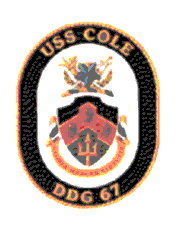 An explosion on the Arleigh Burke-class USS Cole (DDG 67) occurred at about 11:18 AM local time in Yemen [not 12:15 PM as previously reported -- local time in Yemen is seven hours later than Eastern Daylight Time]. USS Cole had completed mooring operations at 9:30 AM local time. The threat level had been raised to threat condition [THREATCON] Bravo when the Cole pulled into the harbor, and they had armed people up on deck. Refueling operations commenced at approximately 10:30 AM local time and were ongoing at the time of the terrorist attack. Initial reports were that the boat that came up alongside the Cole and exploded was part of the mooring operation. However, subsequently it appeared that the boat may have been launched from the shore and may have had no connection with the refueling operation. The explosion caused a 20-foot by 40-foot gash in the port (left) side of the ship. The explosion caused Cole to lose power and disabled all onboard communications assets. Seventeen sailors died in the explosion and more than 35 were injured. All the dead have been recovered.
An explosion on the Arleigh Burke-class USS Cole (DDG 67) occurred at about 11:18 AM local time in Yemen [not 12:15 PM as previously reported -- local time in Yemen is seven hours later than Eastern Daylight Time]. USS Cole had completed mooring operations at 9:30 AM local time. The threat level had been raised to threat condition [THREATCON] Bravo when the Cole pulled into the harbor, and they had armed people up on deck. Refueling operations commenced at approximately 10:30 AM local time and were ongoing at the time of the terrorist attack. Initial reports were that the boat that came up alongside the Cole and exploded was part of the mooring operation. However, subsequently it appeared that the boat may have been launched from the shore and may have had no connection with the refueling operation. The explosion caused a 20-foot by 40-foot gash in the port (left) side of the ship. The explosion caused Cole to lose power and disabled all onboard communications assets. Seventeen sailors died in the explosion and more than 35 were injured. All the dead have been recovered.
|